The majority of us have had to move our offices into our homes due to the current pandemic, and by the looks of it we may be working from home longer than anticipated. It is important to set up an environment that will help your productivity and keep you motivated. There are many articles out there currently offering tips on how to create the best home office space, and for this reason we want to zero in on something specific. Lighting is sometimes forgotten, but it is an extremely important aspect to any space. It affects our mood and overall wellbeing.
We will explore the different types of lighting, offer tips on how to pick the right light bulbs, and explain how this is relevant to your office space.
Does natural light make a difference?
It is definitely hard to be motivated when you have to work from home, especially with so many other distractions. It is one thing to wake up in the morning, have your cup of coffee and head out to your workplace, and a completely different thing to wake up in the morning, have your cup of coffee and sit at your computer. Having enough natural sunlight is especially important if you are working from a home office. If you do not have a designated room for your office, try to find a space in your home that has natural light. A naturally lit space significantly improves health and wellness which can help you to stay focused and be more productive.
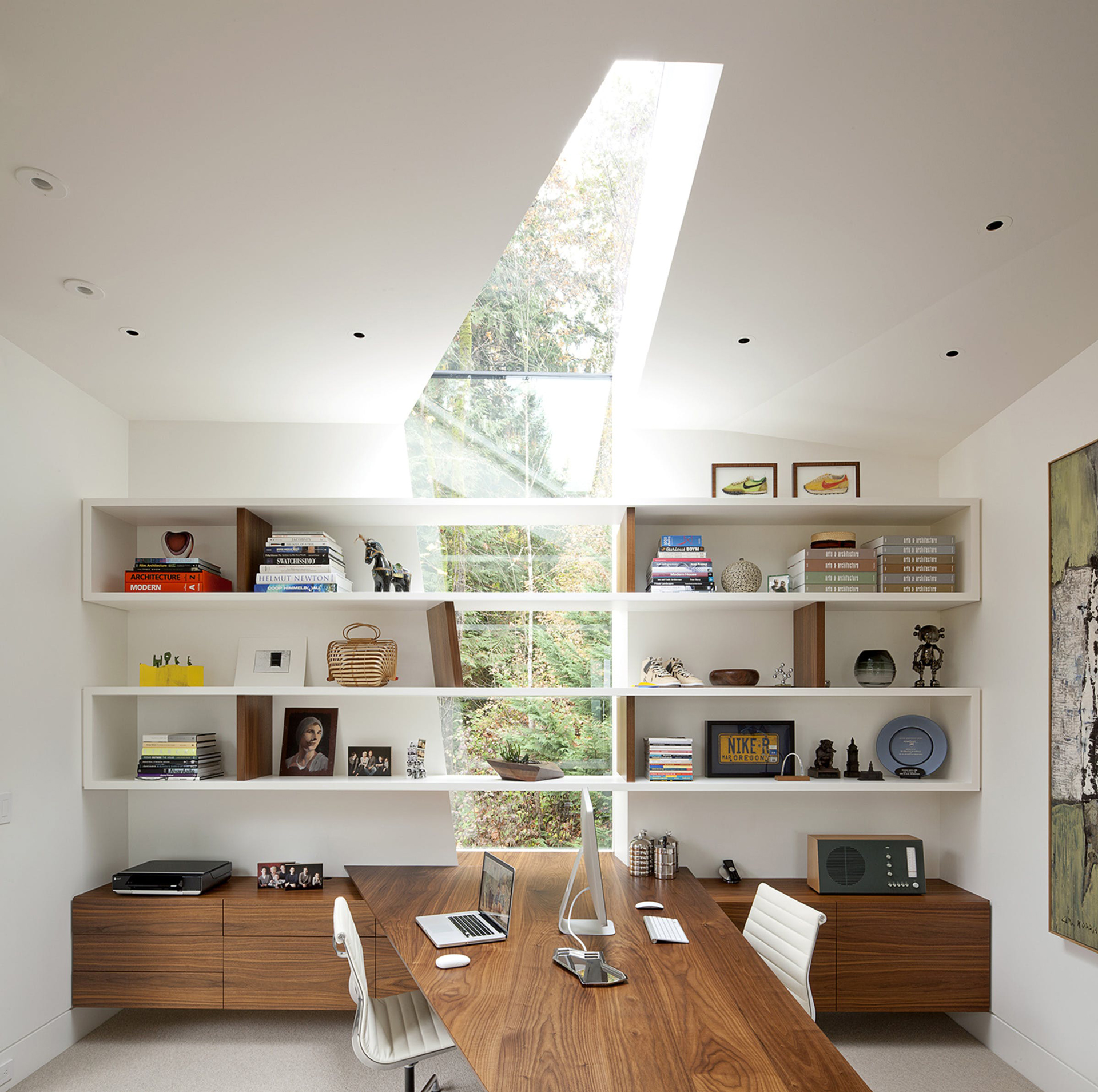
Here are a few ways to maximize natural lighting in your home office!
Window treatments: If you have window treatments, be sure they are operable so that they do not block the natural light from coming in. It is also a great idea to have the option of sheers. Depending on the time of day, and the direction and strength of the sun, it can be too bright if you are working on a computer. Sheers will allow you to temporarily diffuse the light to avoid straining your eyes.
Furniture Placement: Try to keep the space open and airy, and avoid placing large pieces of furniture where it would block the sunlight.
Use of colour: We know that lighter colours reflect, and darker colours absorb sunlight. Having your trim painted a light colour will allow the natural light to amplify the reflection of the natural lighting. Keeping the walls light as well, will help maximize the natural light in the space. Now it does become tricky if you are using a computer to work. You want to avoid reflection, so it is important to understand the tasks that will take place within the space in order to determine the best solution. We will dive deeper into the best lighting while working on a computer.
What is the best lighting while working on a computer?
Constantly staring at our devices has allowed digital eye strain to become a real problem. Proper interior lighting plays a great role in reducing the strain on our eyes. Eye strain can be caused from excessively bright light, either from natural light or harsh interior lighting.

So how do we deal with this?
Location of your computer: Where you setup your workspace is very important. Generally you want your computer screen to avoid direct lighting. A bright light source facing your screen will cause glare and a bright light source behind the screen can make it hard to see. When it comes to natural light, it is best to place your desk and computer perpendicular to the window.
Balance multiple light sources: It is important to remember that balance is everything. Making sure your lighting levels are appropriate for each tasks helps in not over lighting the space. There are typically three types of lighting in each space: natural, overhead and task.
Natural light is a great source, but since it changes throughout the day, it is important to have proper interior lighting. The type of light fixtures and bulbs used can make a huge difference in overhead fixtures. Indirect fixtures that hang from the ceiling will help to evenly distribute the light, and frosted globes can help diffuse it further. Having a dimmer on your switch will also give you more control on how much light is in the room, making it ideal for spaces where tasks constantly change. Office by day, dinner table by night anyone?
It is also handy to have a small task light on your desk, pointed away from the computer because it already gives off light and you want to avoid washing out your screen.
The overall important thing to remember here is that you want to avoid too much contrast between the light from your computer screen, and the light within the space. That being said, the type of bulbs used in any of these light fixtures play a significant role on having the proper lighting.
How do I pick the right light bulb?
We all know that natural sunlight gives us energy, you can just feel the difference on a sunny day as appose to a rainy one. The right light bulb can potentially work the same way. When going to a store like Home Depot, it can be overwhelming as to which light bulb to choose when standing in front of their large display shelf. Trust me, I’ve been there, literally, before I figured out this whole lighting business. In order to choose the right one, we need to understand the differences between them. I know, I know, technical stuff is so dry and boring, but i’ll try my best to make this quick and painless. There are 3 main things to consider, and I will break it down for you:
Decision 1: Incandescent, Compact Fluorescent Lamp Bulb (CFL), Halogen or LED?
You might be thinking to yourself, why are there so many different types of bulbs, it’s ridiculous. The most common ones for the home are Incandescent, Compact Fluorescent Lamp (CFL), Halogen, and LED. The two popular ones homeowners typically purchase are either Incandescent or LED.
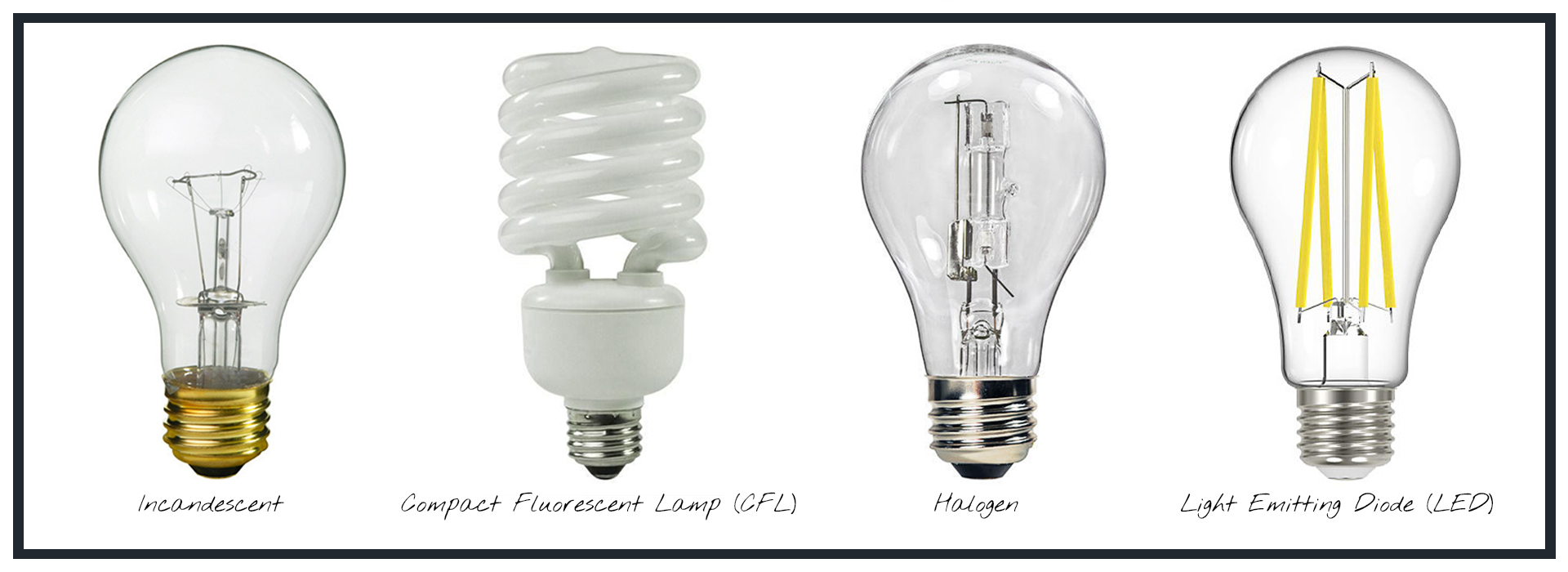
Incandescent bulbs have been on the market since light bulbs existed. They are the traditional warmer tone bulb that are hot to the touch. They tend to be cheapest off the shelf, but don’t get fooled. They tend to suffer when it comes to energy efficiency on your electrical bill, and have to be replaced more often when compared to the alternatives.
Compact Fluorescent Lamp (CFL) bulbs give out a cooler tone which became a great alternative to the Incandescent before the LED evolved. Although they last long and they are energy efficient, they do contain mercury which requires careful handling and disposal. You definitely don’t want one of those bulbs breaking in the house.
Halogen bulbs, while they are a bright white light similar to natural light, they are the least recommended due to the amount of heat they produce. Halogens generate a higher temperature that can burn to touch, as well as have a higher risk to cause a fire if in contact with flammable materials.
LED bulbs have come a long way, and as designers we always recommend going this route in your home. Yes, they do have a higher up front cost; however they have a 3x life span compared to regular incandescent bulb and are the most energy efficient, which ends up saving you money in the long run. LEDs have also come a long way in regards to having the option to be dimmable, a full range of colour temperature from warm or cool, and different decorative bulb styles.
TIP: A dimmable bulb can be used on a non-dimmable circuit. A non-dimmable bulb CANNOT be used on a dimmable circuit.
Decision 2: What Watts (W), Type & Lumens (L) do you need?
First and foremost, the key to selecting the correct bulb is to first look at the labels on your light fixtures, and read what the requirements are. Every light fixture has a sticker near the socket, it will indicate the type and max Watts it can handle.
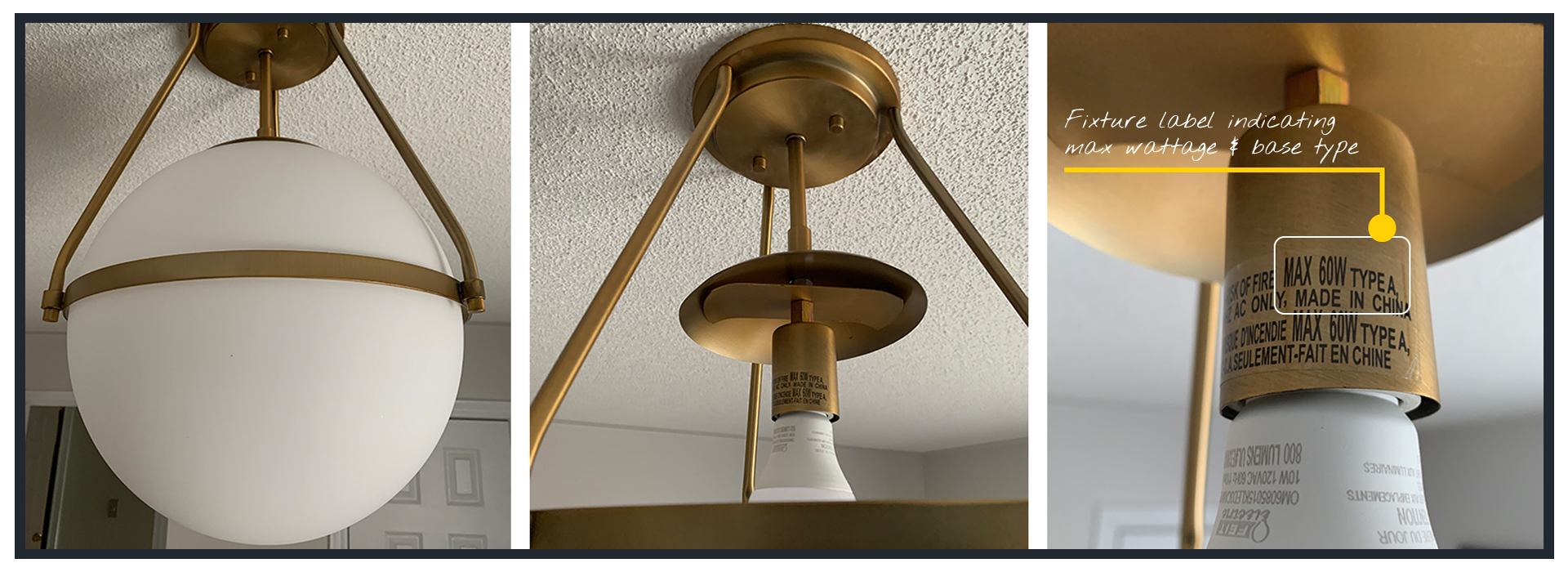
Type is an indication of the base of the bulb, for example ‘Type A or E26’, tells you if the base of the bulb is the right size to screw into the socket.
Watts (W) is how much electricity or energy that light bulb uses. Basically, how much is your electrical bill going to cost! LED packaging will indicate the correct conversion for the consumer to make it easier when purchasing; you will typically see on the box for example ‘60W replacement’ followed by ‘uses only 9W’.
IMPORTANT! do not exceed the Watts suggested on your light fixture; it can end up overheating and could potential cause a fire.
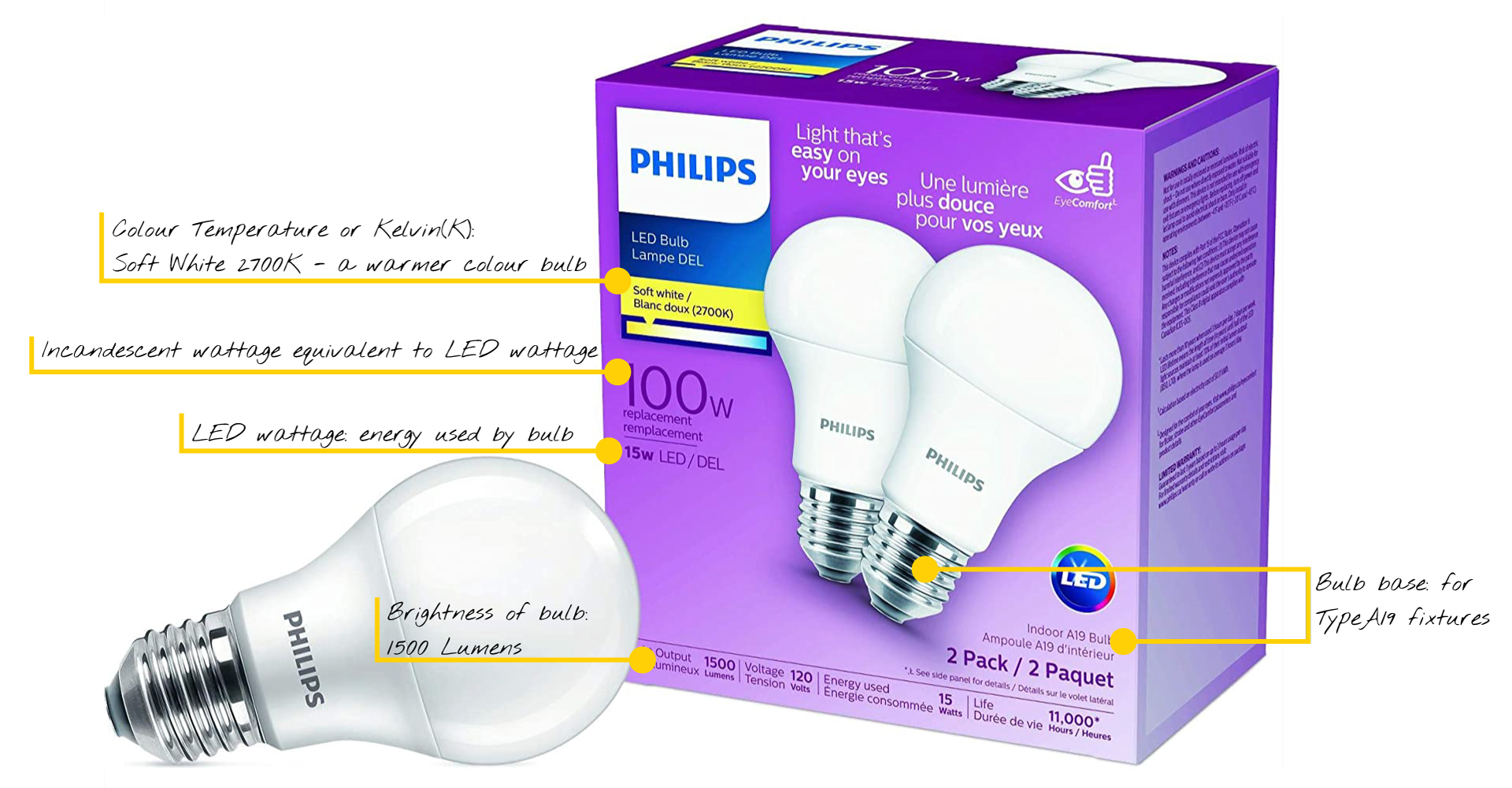
Lumens (L) is how bright a light bulb is, the higher the Lumen number the brighter the bulb. Most of us have no idea how bright 1600 lumens is, but many of us do have some idea of how bright a 100-watt bulb is. And this article is not going to get into Lumens, it is a far more complex calculation that needs to be done, and if you really want the perfect lighting in your home you should consider contacting a specialist. In design school we had an entire semester of learning light calculations and there are many components that need to be considered within the existing space. However, if you are curious about Lumens, I suggest reading this article. The key point here is to understand that a fixture with one bulb can potentially be as bright as one with multiple depending on what bulb Wattage you use.
Here is an example, my upstairs living room has a light fixture that requires one bulb. The only bulb I had laying around the house was a Sylvania brand 23W LED, equivalent to 100W, which is 1600 Lumens. As you can see from the picture, you can land planes with just one bulb. In fact, Sinziana had to drop something off one evening at my house since we’ve been working from our own homes, and she mentioned that she could see it illuminating from down the street; she didn’t need her GPS.
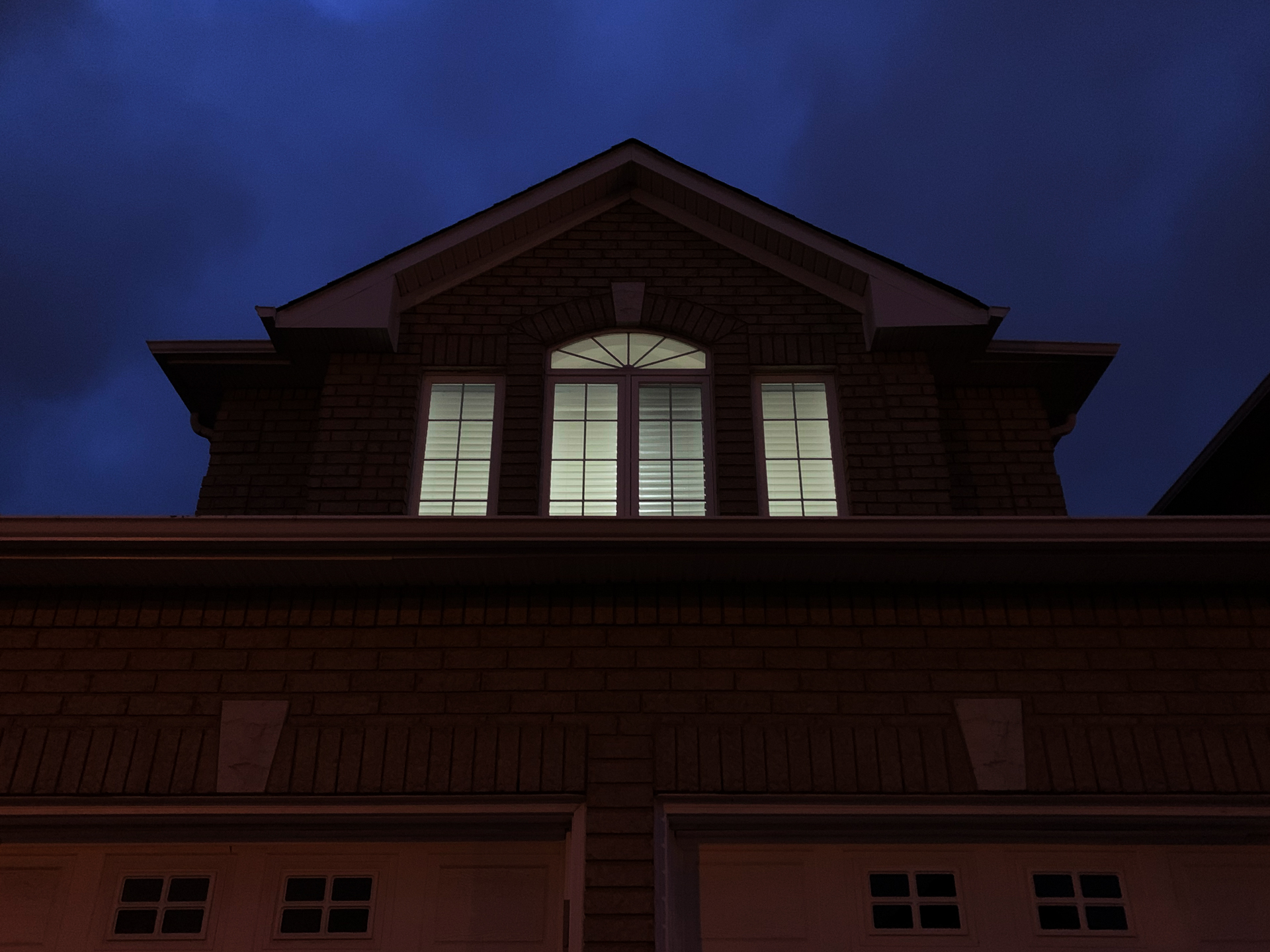
Since the majority of us have to work from home now, small changes in lighting can help to avoid having an over-lit space, and reduce fatigue and headaches. For a common size home office that is typically 100sqft, we are likely dealing with one ceiling mount light that is centered to the room, a few windows and perhaps a desk lamp. In an average home office you are looking at staying in a range of 6,000-8,000 Lumens.
For example, if you have a light fixture like the Asher 12-Light Sputnik Sphere Chandelier, which is a very popular style now, 12 LED bulbs of 9w (or 60w) at 800 Lumens each is 9,600 Lumens all together. Take in consideration if you have lots of natural light during the day, light or dark walls, light or dark furniture, reflective or matt surfaces and you may have just over lit your space. The solution in this case would be to use a lower watt bulb, for example this particular fixture can use a LED 4w (or 40w) at 450 Lumens which will then bring you down to 5,400 Lumens . (please keep in mind this is an example, be sure to check the package of the bulbs that you are considering for the correct Watt conversion because they may vary.)
Decision 3: What Colour Temperature (Kelvin (K)) do I need?
Colour Temperature also known as Kelvin (K), is one of the most important aspects of a light bulb. This tells you if the light will be warmer (yellow) or cooler (blue). The lower the number, the warmer the colour and the larger the number, the cooler. We typically recommend a colour temperature for your home office that is between 3500-5500K, anything less the 3,500 is warmer and general gives you a cozier relaxed atmosphere. Anything above, is just too blue which can become tiring on the eyes. Someone accidentally purchased a 7000k bulb, which I didn’t even think existed at Home Depot, and when I walked into the office, it was like a scene from Men in Black when that flash of light erased my memory. All joking aside being in the room for no more than an hour actual made me feel dizzy, needless to say that had to be replaced.
Kelvin temperature colour scale by Lumens Light and Living Desk Lamp Colour Temperature 2700K (left) vs 6500K (right)
Key Points to Lighting Your Home Office
Alright, that was a lot of information, thanks for hanging in there. Hopefully this article will make your life a little easier when it comes to creating the right lighting environment for your home office. The key points to remember are this. Lighting is an extremely important aspect to any space, especially your home office. Each room should be illuminated based on its use. Use different forms of light sources to do so like natural light, overhead lighting, and task. As for the home office, if you don’t have a designated room try to locate a space where you can have natural light. We suggest the LED bulbs, not only are they energy efficient, they also last long, so you don’t always have to scramble to find a light bulb to replace. Also, when buying a light bulb, make sure to select the correct watts and colour temperature.
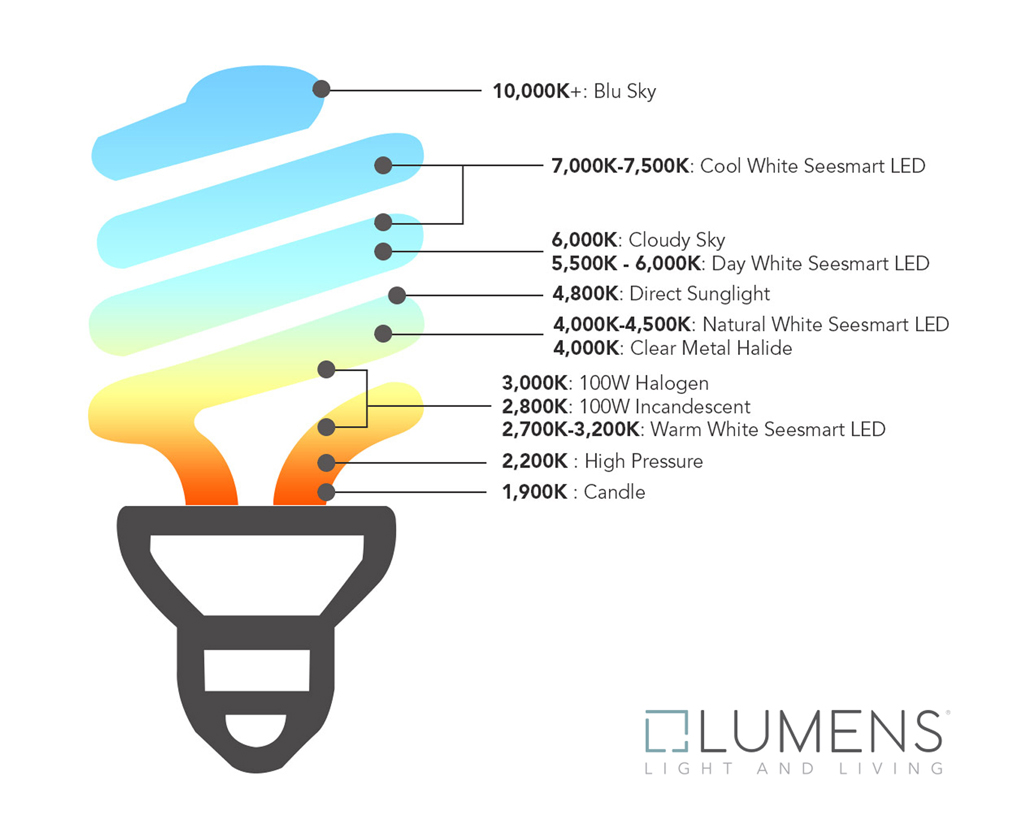
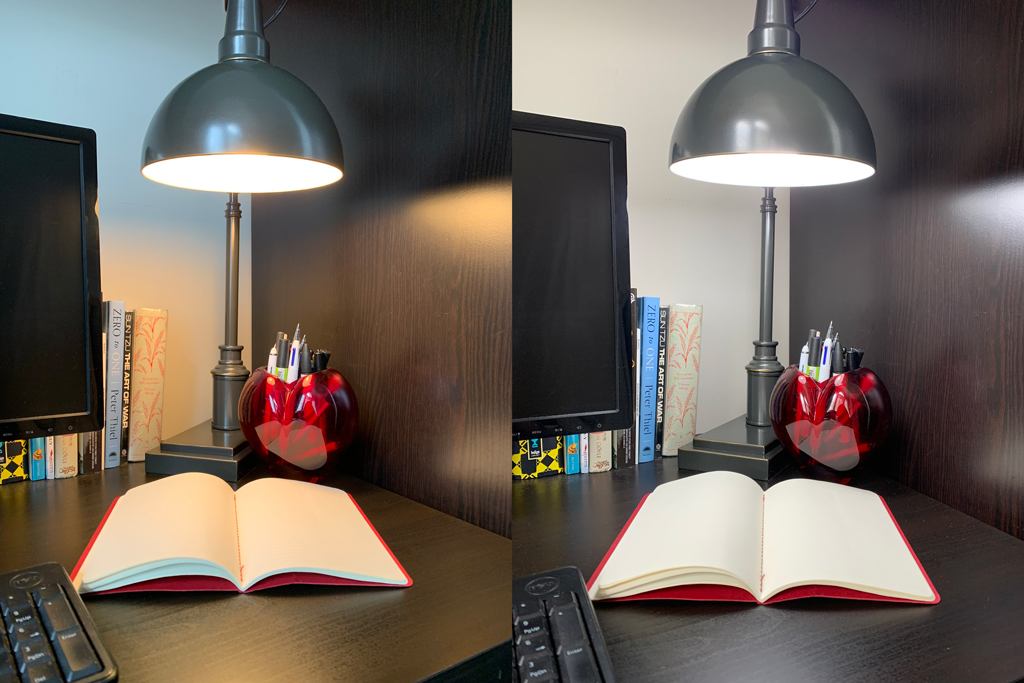


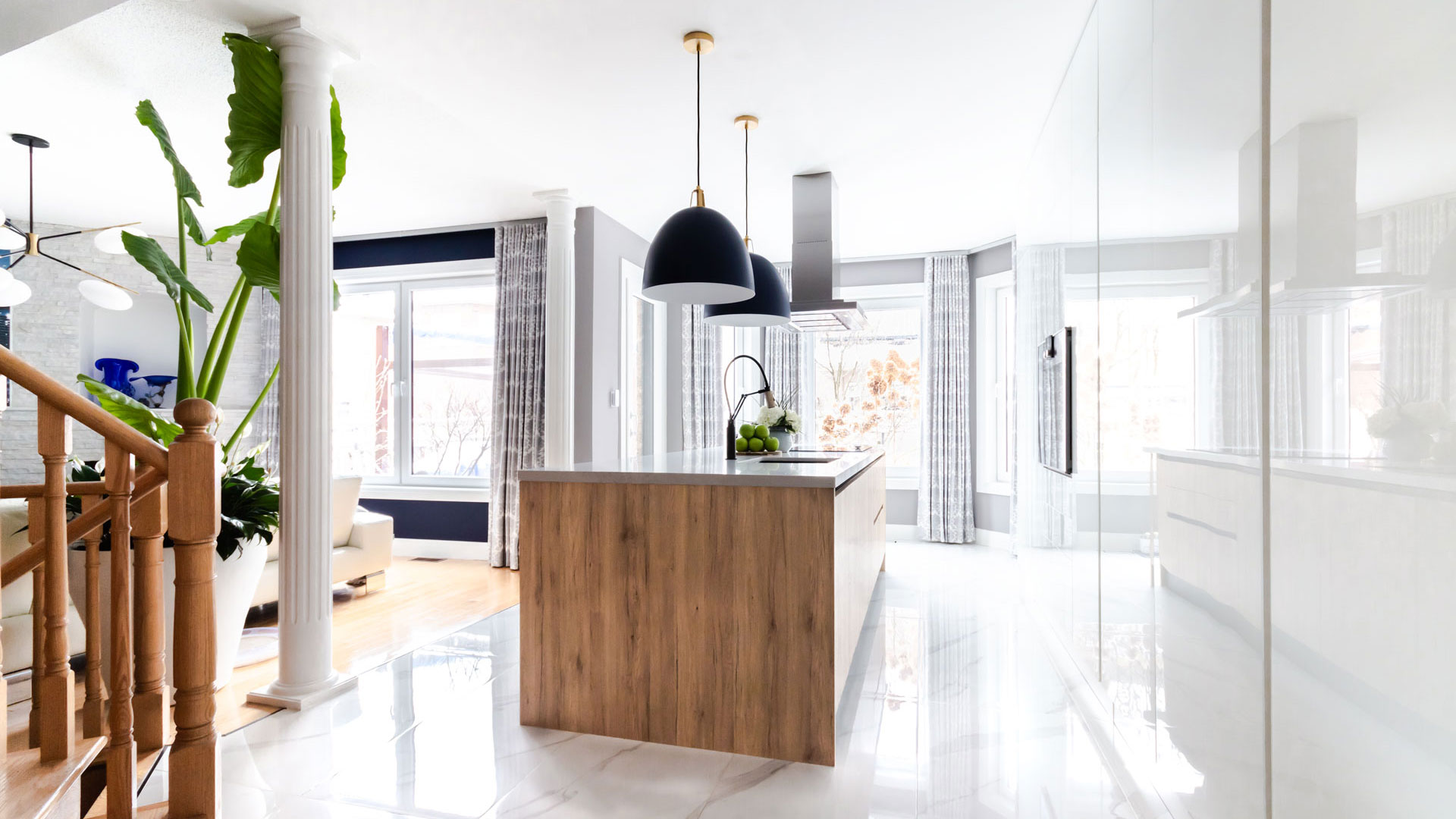

Leave a Reply
You must be logged in to post a comment.